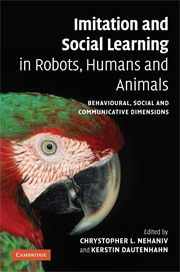 Imitation and Social Learning in Robots, Humans and Animals
Imitation and Social Learning in Robots, Humans and Animals Book contents
- Frontmatter
- Contents
- List of plates
- List of figures
- List of tables
- List of contributors
- Introduction: the constructive interdisciplinary viewpoint for understanding mechanisms and models of imitation and social learning
- Part I Correspondence problems and mechanisms
- Part II Mirroring and ‘mind-reading’
- 4 A neural architecture for imitation and intentional relations
- 5 Simulation theory of understanding others: a robotics perspective
- 6 Mirrors and matchings: imitation from the perspective of mirror-self-recognition, and the parietal region's involvement in both
- Part III What to imitate?
- Part IV Development and embodiment
- Part V Synchrony and turn-taking as communicative mechanisms
- Part VI Why imitate? – Motivations
- Part VII Social feedback
- Part VIII The ecological context
- Index
- Plate section
- References
6 - Mirrors and matchings: imitation from the perspective of mirror-self-recognition, and the parietal region's involvement in both
Published online by Cambridge University Press: 10 December 2009
- Frontmatter
- Contents
- List of plates
- List of figures
- List of tables
- List of contributors
- Introduction: the constructive interdisciplinary viewpoint for understanding mechanisms and models of imitation and social learning
- Part I Correspondence problems and mechanisms
- Part II Mirroring and ‘mind-reading’
- 4 A neural architecture for imitation and intentional relations
- 5 Simulation theory of understanding others: a robotics perspective
- 6 Mirrors and matchings: imitation from the perspective of mirror-self-recognition, and the parietal region's involvement in both
- Part III What to imitate?
- Part IV Development and embodiment
- Part V Synchrony and turn-taking as communicative mechanisms
- Part VI Why imitate? – Motivations
- Part VII Social feedback
- Part VIII The ecological context
- Index
- Plate section
- References
Summary
Introduction
In the movie Duck Soup, the Marx Brothers Harpo and Groucho come upon each other, face to face. There would have been a mirror between them, but Harpo, in his attempt to avoid being seen by Groucho whom he had been impersonating, ran into it and broke it. The two men look alike; to avoid detection, Harpo imitates Groucho's movements to make it appear that Groucho is seeing himself in a mirror. Testing the “mirror” image, Groucho performs a series of bizarre actions that Harpo imitates simultaneously, thereby supporting the ridiculous conclusion that Groucho is indeed looking in a mirror. The sequence nicely illustrates the similarities between bodily imitation and mirror images. In both, actions of one entity closely mimic the actions of another, such that a resemblance is apparent. Consequently, it seems reasonable to expect that the same processes that allow someone to imitate another person's actions (or to recognize that one's actions are being imitated) might also be useful in determining that the image in the mirror is oneself.
Remarkably, the first explicit recognition of the similarity between bodily imitation and mirror-self-recognition was quite recent, in 1925 by French psychologist Paul Guillaume, in his book about the imitative development of his daughters. Guillaume (1926/1971, p. 152) argued “We must not hesitate to connect this exceptional mirror experiment [i.e., the child's infrequent interactions with mirrors] with the experience of normal imitation. Other adults and also other children in the society in which he lives are for the infant the natural mirror that reflects for him his own image when he proceeds to imitate.”
- Type
- Chapter
- Information
- Imitation and Social Learning in Robots, Humans and AnimalsBehavioural, Social and Communicative Dimensions, pp. 103 - 130Publisher: Cambridge University PressPrint publication year: 2007
References
- 3
- Cited by


